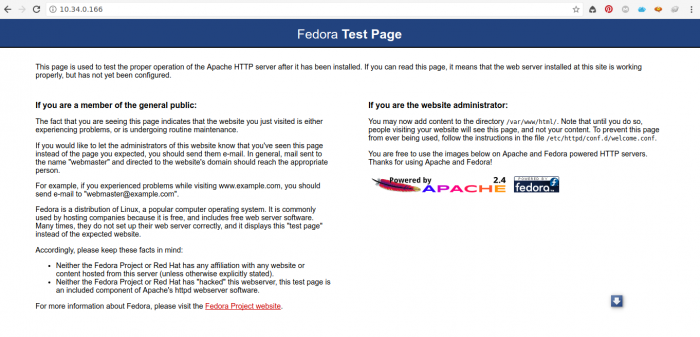
Fedora Tutorial – Hello Linux, today we will show you how to install LAMP Server on Fedora 26. LAMP Server is an essential parts if you want to build a powerful, rock solid web application server. LAMP Server and Fedora 26 is a great combination for your server. LAMP Server is combination between Linux, Apache, MySQL/MariaDB and PHP. And today we will guide you step by step install LAMP Server on Fedora 26. After we have LAMP Server installed on our system, we can then install various web application such as Owncloud, Nextcloud, Pydio and many more.
Steps to install LAMP Server on Fedora 26
Step 1. Enable EPEL and REMI Repository
First, we need to enable EPEL and REMI repository on Fedora 26. Please visit our previous tutorial to enable these repositories.
Step 2. Install Apache web server
First we need to install Apache web server. Log in to Fedora server and execute this command as root
dnf --enablerepo=remi,epel install httpd
Output sample
[root@fedora ~]# dnf --enablerepo=remi,epel install httpd determining the fastest mirror (33 hosts).. done. Remi's RPM repository - Fedora 26 - x86_64 1.3 MB/s | 1.3 MB 00:01 Last metadata expiration check: 0:00:01 ago on Tue 22 Aug 2017 07:30:14 PM WIB. Dependencies resolved. ============================================================================================================ Package Arch Version Repository Size ============================================================================================================ Installing: httpd x86_64 2.4.27-2.fc26 updates 1.3 M Installing dependencies: apr x86_64 1.6.2-1.fc26 updates 118 k apr-util x86_64 1.5.4-5.fc26 fedora 95 k fedora-logos-httpd noarch 26.0.1-1.fc26 fedora 33 k httpd-filesystem noarch 2.4.27-2.fc26 updates 27 k httpd-tools x86_64 2.4.27-2.fc26 updates 88 k mod_http2 x86_64 1.10.10-1.fc26 updates 149 k Transaction Summary ============================================================================================================ Install 7 Packages Total download size: 1.8 M Installed size: 4.8 M Is this ok [y/N]:
Start and enable Apache
systemctl enable httpd systemctl start httpd
Enable http through firewalld
firewall-cmd --add-service=http --permanent firewall-cmd --add-service=https --permanent firewall-cmd --reload
Now open web browser and type the Fedora 26 IP address. You should see the following page.
At this point, our Apache web server is running and well configured.
Step 3. Install MariaDB
To install MariaDB, use the following command
dnf --enablerepo=remi,epel install mysql-server
The command will install MariaDB instead of MySQL Server. But that’s oke since MariaDB is a fork of MySQL Server. After install, start and enable MariaDB
systemctl start mariadb systemctl enable mariadb
The next step is to secure the MariaDB. The default MariaDB password is none. Simply press Enter when asked.
mysql_secure_installation
Output:
[root@fedora ~]# mysql_secure_installation
NOTE: RUNNING ALL PARTS OF THIS SCRIPT IS RECOMMENDED FOR ALL MariaDB
SERVERS IN PRODUCTION USE! PLEASE READ EACH STEP CAREFULLY!
In order to log into MariaDB to secure it, we'll need the current
password for the root user. If you've just installed MariaDB, and
you haven't set the root password yet, the password will be blank,
so you should just press enter here.
Enter current password for root (enter for none):
OK, successfully used password, moving on...
Setting the root password ensures that nobody can log into the MariaDB
root user without the proper authorisation.
You already have a root password set, so you can safely answer 'n'.
Change the root password? [Y/n] y
New password:
Re-enter new password:
Password updated successfully!
Reloading privilege tables..
... Success!
By default, a MariaDB installation has an anonymous user, allowing anyone
to log into MariaDB without having to have a user account created for
them. This is intended only for testing, and to make the installation
go a bit smoother. You should remove them before moving into a
production environment.
Remove anonymous users? [Y/n]
... Success!
Normally, root should only be allowed to connect from 'localhost'. This
ensures that someone cannot guess at the root password from the network.
Disallow root login remotely? [Y/n] n
... skipping.
By default, MariaDB comes with a database named 'test' that anyone can
access. This is also intended only for testing, and should be removed
before moving into a production environment.
Remove test database and access to it? [Y/n] y
- Dropping test database...
... Success!
- Removing privileges on test database...
... Success!
Reloading the privilege tables will ensure that all changes made so far
will take effect immediately.
Reload privilege tables now? [Y/n] y
... Success!
Cleaning up...
All done! If you've completed all of the above steps, your MariaDB
installation should now be secure.
Thanks for using MariaDB!
Step 4. Install PHP
Now install PHP with the following command
dnf --enablerepo=remi,epel install php php-mysql
Output
root@fedora ~]# dnf --enablerepo=remi,epel install php php-mysql Last metadata expiration check: 0:50:59 ago on Tue 22 Aug 2017 07:30:14 PM WIB. Dependencies resolved. ============================================================================================================ Package Arch Version Repository Size ============================================================================================================ Installing: php x86_64 7.1.8-1.fc26.remi remi 2.8 M php-pecl-mysql x86_64 1.0.0-0.15.20160812git230a828.fc26.remi.7.1 remi 40 k Installing dependencies: php-cli x86_64 7.1.8-1.fc26.remi remi 4.2 M php-common x86_64 7.1.8-1.fc26.remi remi 1.0 M php-json x86_64 7.1.8-1.fc26.remi remi 60 k php-mysqlnd x86_64 7.1.8-1.fc26.remi remi 229 k php-pdo x86_64 7.1.8-1.fc26.remi remi 123 k Transaction Summary ============================================================================================================ Install 7 Packages Total download size: 8.4 M Installed size: 31 M Is this ok [y/N]:
Now we have Apache, MariaDB and PHP installed on Fedora 26. At this point, our LAMP Server is ready. Thank you for reading this how to install LAMP Server on Fedora 26. See you on the next tutorial.


Leave a Reply